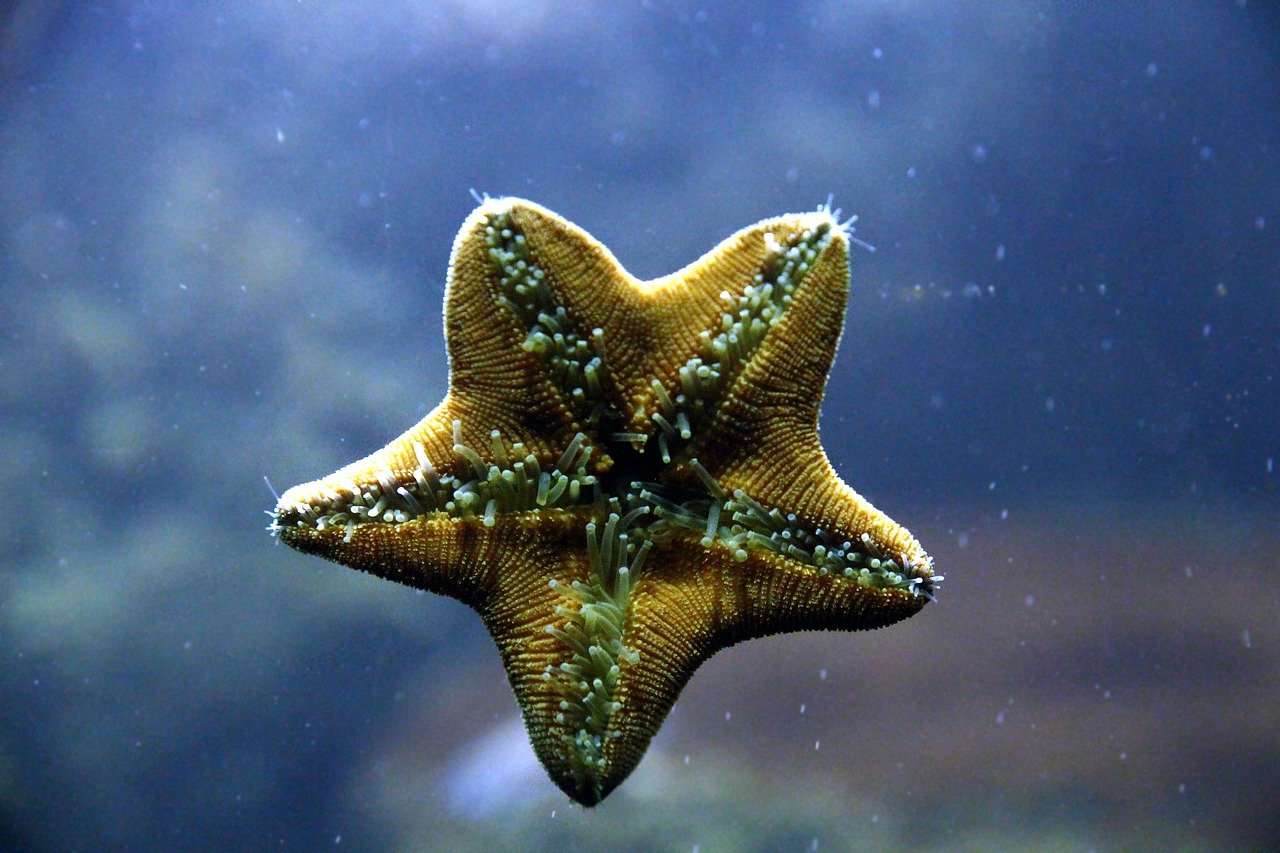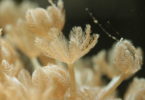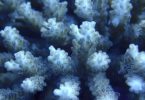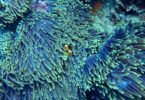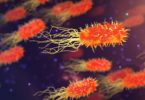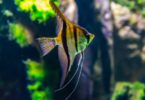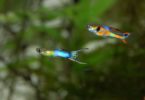Last Updated on November 19, 2022 by Matt
Echinoderms are any member of the 7,000 or so living species in the phylum Echinodermata. It is the largest phylum which contains no terrestrial or freshwater species; all species within this phylum are exclusively marine. The Echinodermata contain five extant classes in three subphylums; the starfish, sand dollars, brittle stars, sea urchins, sea cucumbers, and sea lilies. This article dives deep into the role of the Echinoderms and its importance in our ecosystem.
Adult echinoderms are characterized by their radial symmetry, and which is normally five-point as seen in typical starfish. They also have a calcium carbonate shell, which are often collected for decoration.
In this article we will run through the general characteristics of echinoderms that all groups possess, before focusing on the different groups and giving a general description of their key features and the species which are most commonly kept in the home aquarium.
IN THIS ARTICLE
General Characteristics of Echinoderms
All groups of echinoderms are closely related, being in the phylum Echinodermata. Therefore they all share similar basic characteristics.
Morphology and Anatomy
All echinoderms exhibit radial symmetry. Animals possess a central structure surrounded, normally, by five equal parts, like spokes on a wheel rather than the usual bilateral symmetry. This symmetry is most easily seen in the sea stars and brittle stars, with five equal arms, but if you dissect any echinoderm you will find that their bodies are arranged in a five fold repeating pattern. However the radial symmetry is secondary, echinoderm larvae exhibit bilateral symmetry.
An internal skeleton of calcium carbonate is present, as bony plates or ossicles. This is known as the ‘test’. In sea urchins the ossicles are fused, but sea stars and brittle stars can flex their arms which shows the ossicles have breaks and gaps to enable this. In sea cucumbers the skeleton is greatly reduced. The spins seen on many species, such as the sea urchins, are actually extensions of the skeleton.
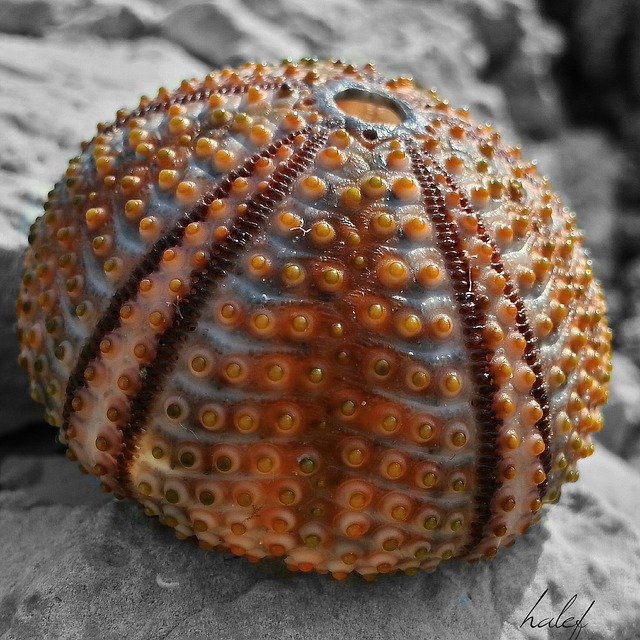
Sea urchin test, showing the fused calcium carbonate ossicles
Echinoderms lack a typical head, and have a very basic nervous system, lacking eyes or other organs to sense complex stimuli. Instead echinoderms have very basic tactile receptors which differentiate between light and dark. However they do have a very keen chemoreception, and use this as their main way of knowing what is in their surrounding environment.
The oceans are filled with larvae and algae which are looking for attachment sites, and often find themselves growing on crab shells and other animals. Echinoderms have developed a unique way of fending off pesky encrusting organisms; they are covered with defensive structures called pedicellaria. Pedicellariae are small claw-shaped appendages which are capable of independent reflex responses.
In general the skin of echinoderms is a formidable defence against predation, being thick and containing a combination of spines, poisonous mucus, and toxins.
Another brilliant predation defence is their regeneration ability, showcased best by sea stars. When caught by a predator, they will simply drop the caught arm and escape, leaving the predator with a moving arm, being able to regrow a fully functional arm later. Sea urchins constantly lose and regrow spins, while sea cucumbers discharge their internal organs as a defence mechanism and then regrow the lost organs.
Regeneration also enables asexual reproduction, with some sea cucumbers and sea stars able to spilt in two and regrow. Some species of sea stars are able to fully regrow an adult from a single severed arm.
Water Vascular System
Echinoderms are unique in that they possess a water vascular system, which isn’t found in any other group of animals. This water vascular system consists of a central ring canal and radial canals that extend along each arm, and is involved in gas exchange, locomotion, sensory reception, and feeding.
Lateral canals branch off the radial canal, and end in ampullae which can extend through pores in the skin. Extended ampullae are known as tube feet. As water is redistributed throughout this system, water pressure changes and enables movement; as water is forced into the ampulla the tube feet extend and harden.
The water vascular system is open to the outside, and water is drawn into the system via the madreporite, or sieve plate. The madreporite can be seen as a small wart-like structure, usually on the aboral surface. It acts as a pressure-equalizing valve, sieving water as it enters the water vascular system via the stone canal and joins the ring canal that surrounds the mouth.
Starfish

The starfish, or sea stars, are easily the most famous and well-known of the echinoderms, and are members of the class Asteroidea. They are very closely related to the brittle stars, as they are both members of the subphylum Asterozoa. Starfish are very diverse; there are some 2,000 species found throughout the world’s oceans, from the shallows to the depths of the sea, and from the tropics to the poles.
Starfish are so called because the majority of species have five arms, although there are species which have as many as 40 arms. They have distinct upper and lower portions, with the upper portion being covered with bony calcified skin which forms a protective layer against predation. Many species are very brightly colored for camouflage, or to ward off potential predators. The underside of starfish is very different; on the arms are found many tube feet, which are used for locomotion and also aid in respiration. The central disk of sea stars contains the mouth and anus, although in some species these are the same.
Most sea stars are quite specialized feeders, although most can eat virtually anything if food is at a premium. Most sea stars are carnivorous predators of mollusks such as mussels, clams, oysters, and snails, while others prefer coral polyps, and sponges. The crown of thorns starfish is perhaps the most infamous coral eater, being the cause of some devastation on the Great Barrier Reef. Other species are planktivores, and others eat detritus.
By far the easiest sea stars to keep in a home aquarium are the detritivores and the algae eating species. Those in the genera Linkia and Fromia are very popular, as they are beautifully colored and patterned, while leaving corals and sponges alone. As such they are fully reef safe, though fare better in well-established aquariums where there is plenty of algal growth and microfauna. Their diet should be supplemented with small pieces of crab, shrimp, and flaked foods so that they don’t start to look at corals with a hungry eye.
When introducing coral polyps and live rock into your reef tank, always check that you haven’t got any hitchhikers. Starfish of the Asterina genus are very small, and are often introduced accidentally to tanks. They can reproduce very quickly, as they can reproduce asexually via fragmentation. While most Asterina species are rather innocuous, some can be formidable coral eaters, and decimate tanks. If you start to see white marks on coral polyps, remove these critters, though it is always best not to get them in the first place.
Brittle Star
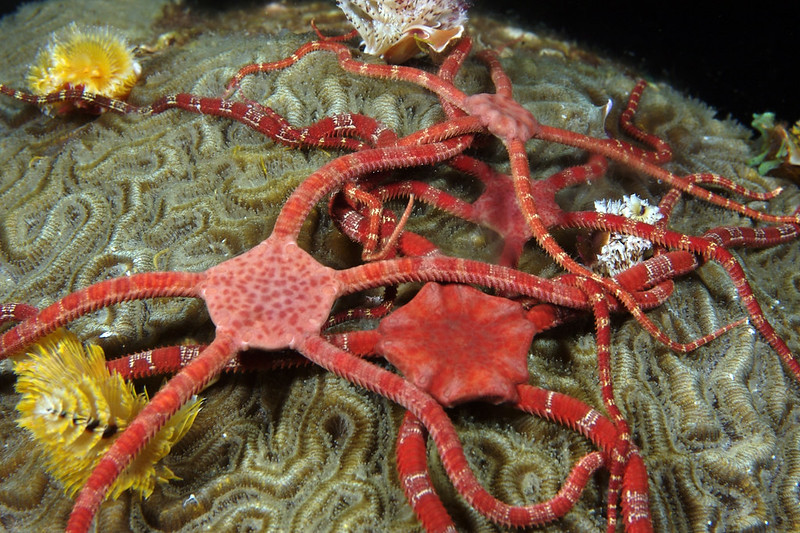
Very closely related to sea stars, brittle stars are members of the class Ophiuroidea and are also known as the serpent stars. While they look similar to sea stars, they have some key anatomic differences. The underside of their thin arms do not have the grooves that are found in the sea stars, and their tube feet aren’t involved in passing food to the mouth, or in the movement, instead only being sensory in function. Instead the arms themselves are used for locomotion.
They have a worldwide distribution and are found at almost every water depth, however most are below 500 meters. The vast majority of brittlestars are herbivores or detritivores, which makes them perfect for the home reef aquarium, as there is no chance of them eating your prized corals or sponges! Some large species can catch small slow moving fish however. In fact having these animals in an aquarium can be extremely beneficial to its health and long term maintenance, as they are quite voracious detritus and algae eaters.
Brittle stars, unlike their cousins the sea stars, don’t like bright light and during daylight hours spend their time hiding under rocks, in crevices, and under substrate until they come out to feed at dusk and during the night.
Pretty much any species of tropical brittlestar can be kept in an aquarium, though be careful about green brittle stars, as they are known fish eaters. Species such as the Red Fancy Brittle Star (Ophothrix Fraggillis) and Fancy Tiger Striped Brittle Star (Ophiolepsis superba) are commonly kept species.
Sea Urchin
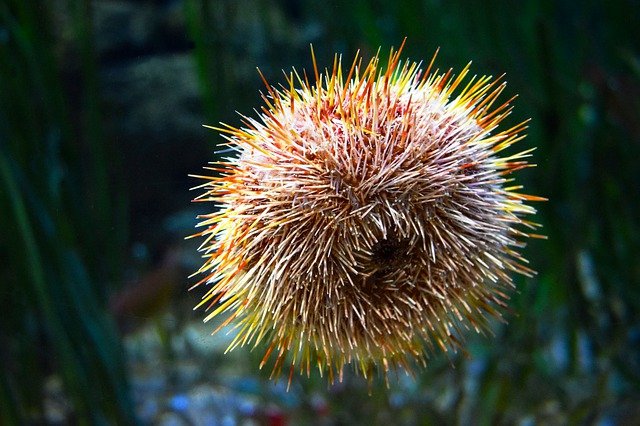
Sea urchins belong to the class Echinoidea, and are typically round, globular invertebrates which are found on the seafloor of all the world’s oceans, from the intertidal zone all the way to depths of 16,000 feet. However they are most common in shallow reef ecosystems. There are around 950 species of sea urchin. They are nocturnal animals, hiding in crevices during daylight hours and coming out at dusk to feed.
Sea urchins are characterized by their long spines. These spines can be very thin and long, or very broad. In many species the spines hold venom, and can deliver a painful blow even to humans. The largest spines can be 12 inches long. Spines are attached to the calcium carbonate skeleton via ball and socket joints, not unlike a human shoulder, which allows them a wide range of movement. Tube feet are found between the spines, which are used for locomotion. The skeleton is made of fused calcium carbonate ossicles.
The vast majority of sea urchins are herbivorous, feeding mainly on algae, with some species having voracious appetites for macroalgae like kelp. Some species are predatory, feeding on animals such as sea cucumbers, mussels, polychetes, and sponges. They have a number of predators, being a human delicacy and the favorite food of animals such as sea otters, octopuses, triggerfish, and wolf eels.
With most species being herbivorous, sea urchins make an amazing addition to any reef tank. Common species found in home reef tank setups include the Blue Tuxedo Urchin, Black Longspine Urchin, Pencil Urchin, and Shortspine Urchin.
Sand Dollar
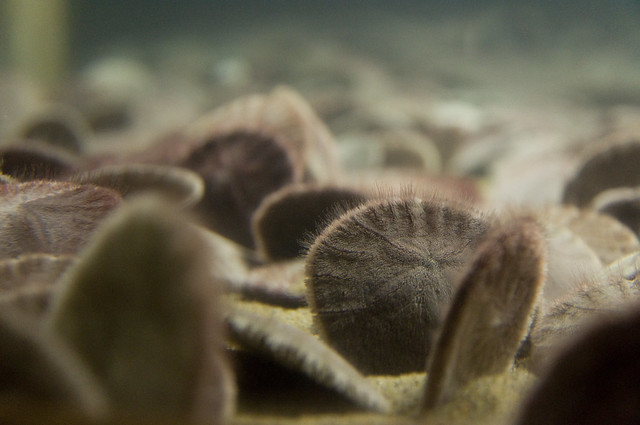
Sand dollars in the Monterey Bay Aquarium in California. Credit: Jonathan Kriz (Flickr)
Sand dollars belong to the same class as the sea urchins, the Echinoidea, and are in the order Clypeasteroida. Essentially they are flattened sea urchins, many species being very thin dorso-ventrally. Some within the order are much less flattened and are known as sea biscuits.
Sand dollars are benthic creatures, and live in soft and sandy substrates, where they bury themselves as protection from predators. The test is covered in velvety short spines, which are themselves covered in cilia. Locomotion is conducted by coordinated movement of the spines. The mouth is found on the underside of the body, in the center of the central disk. Food grooves point towards the mouth, which are lined with podia which move food items toward the mouth.
A sand dollar’s diet consists of diatoms, algae, crustacean larvae, small copepods, and detritus. The same is true in aquariums. This can be a problem, as most aquariums are kept very clean, with regular cleanings including the substrate through the use of an aquarium vacuum cleaner. Having a clean tank system is essential for a healthy fish and corals etc, but sand dollars need waste and algal growth as food. The conundrum lies in that if waste is left to build up, dangerous compounds such as ammonia, nitrite, nitrate, and phosphate will build, altering water chemistry, which will impact the sand dollars as well as everything else.
Spot feeding sand dollars seems like the best option, but they are quite difficult to keep healthy in the home aquarium, and so are reasonably rare in the trade.
Sea Cucumber
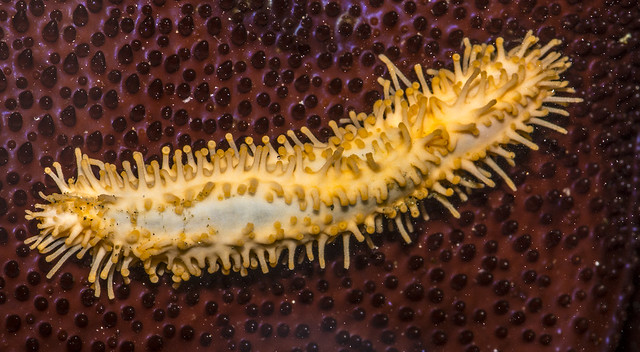
Credit: Jerry Kirkhart (Flickr)
Sea cucumbers are echinoderms in the class Holothuroidea. They have very leathery skin, and are elongated, and are one of the few echinoderms to retain some form of bilateral symmetry into adulthood, although they also show radial symmetry. There are around 1,717 species of sea cucumber found in all of the world’s oceans, with the greatest diversity being in the Indo-Pacific region. They can be found in great numbers at great depths, often forming a large percentage of total animal biomass; at depths greater than 5.5 miles sea cucumbers compose around 90% of the total macrofauna biomass.
Most sea cucumbers are benthic scavengers, feeding on the algae and detritus that is found on the seafloor. There are exceptions, such as pelagic sea cucumbers and a species which has a symbiotic relationship with a deep sea anglerfish. Some species have specialized tentacles for filter feeding.
The majority of sea cucumbers range from 4-12 inches long, though the smallest is 0.1 inches and the largest is 40 inches long.
Unlike other echinoderms their calcium carbonate skeletons are greatly reduced, being only single ossicles, although some species have more present for protection. Sea cucumbers move using a combination of their tube feet and rhythmic body contractions.
Sea cucumbers are best kept in an invertebrate or reef tank. They are for very experienced aquarists only, as while they won’t attack fish or eat corals, their main defence mechanism is to expel their internal organisms. These expulsion can be very toxic and poisonous to fish. In an enclosed system like an aquarium this can be devastating. So great care is needed.
Water quality must be extremely high, and great care must be taken to ensure that the sea cucumber doesn’t get sucked into water inflows and outflows. It seems a bit ridiculous but it is a problem!
Common species include those in the Holothuria genus, and the Spiny Sea Cucumber Pentacta anceps.
Crinoid
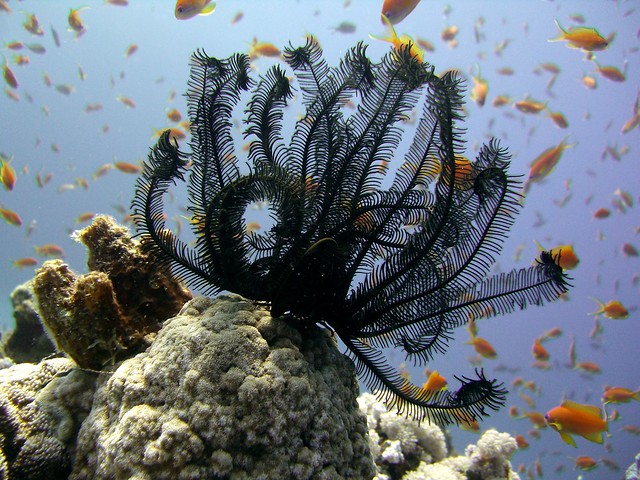
Credit: Tim Sheerman-Chase (Flickr)
Crinoids are animals in the class Crinoidea of the phylum Echinodermata. Included in the crinoids are the feather stars and sea lilies. The two are differentiated by the presence of a stalk in adult animals; feather stars don’t possess a stalk, while sea lilies do.
Crinoids look absolutely majestic; they have long feathery arms which they use to collect passing food items from the water column. Mucus on the tube feet trap food, where it is then passed to the mouth by beating cilia.
The basic morphology of a crinoid is split into the stalk and the crown; the crown contains the arms and a cup-like central body called the theca, while the stalk contains the holdfast and stem. Calcium carbonate again makes up the skeleton, and accounts for 80% of the animal, with soft tissue the vast minority. The number of arms varies from five up to around 200, but always in a multiple of five.
While sea lilies are deep water animals and are normally sessile, attaching themselves via a holdfast, feather stars can ‘walk’ on cirri at the base of the stalk, which they also use to attach themselves once they find a good spot. Some species can also swim using the long arms.
Sea lilies are nocturnal feeders, hiding during daylight and emerging at night to feed. While they are passive feeders of passing algae they do move to find better spots for feeding.
Feather stars can be kept in a home aquarium, as they are found in tropical reefs. Sea lilies are deep sea animals and aren’t suitable. However keeping feather stars is only for expert aquarists who want a unique challenge. They need perfect water chemistry, strong water flow, and constant feeding. Automatic feeders should be used, as well as spot feeding the feather stars. They need a mixture of detritus, plankton, and small zooplanktonic animals.
Conclusion
Keeping echinoderms in a reef aquarium is an opportunity to bring a fascinating piece of natural history into the tank.
There are many species of echinoderms that do very well in aquaria and can be kept by aquarists of any experience level, such as starfish, brittle stars, and sea urchins.
For expert and experienced aquarists who want a new challenge, species such as sand dollars, sea cucumbers, and feather stars present a perfect place to start.
Remember that as echinoderms have a water vascular system that is open to the outside via the madreporite, they are very sensitive to changes in water chemistry. They need a very stable environment and temperature, carbonate hardness, pH, magnesium and calcium levels, and nitrogenous and phosphorous compounds to remain in healthy ranges. Phosphate removers can be used to reduce phosphate levels, and there are similar products for nitrogenous compounds. A good protein skimmer is essential for a clean healthy environment. Regular water changes should be undertaken to maintain the environment. Water changes can be made easier using a product like the Python water changer. TO keep the water chemistry stable, it is recommended to use RODI water for water changes.

